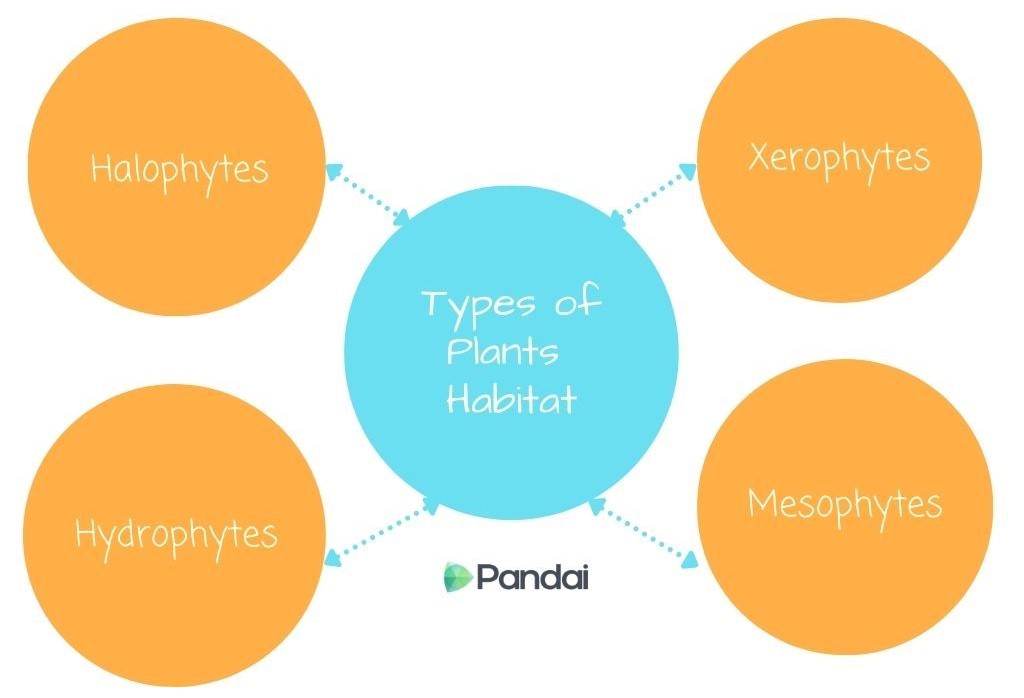| |
|
|
| |
| Adaptation |
- Adaptation is the adjustment of an organism to the environment.
- All organisms adapt.
- Animals and plants have unique structures and shapes to adapt to the environment to ensure the survival of the species.
- For a plant, this adaptation can be observed in the shape of its leaves, roots, and stem, to adjust itself to live in its habitat.
|
|
| |
 |
| |
| Classification of Plants based on Habitats |
- Plants that live in swampy habitats at the river mouth, the meeting point of fresh water and seawater. This swampy area is rich in salt content.
- Example:
- Avicennia sp.
- Sonneratia sp.
- Rhizophora sp.
- Brugeria sp.
- Pandanus sp.
- Nyla sp.
|
- Plants that live in a habitat that is not too dry nor too wet with an adequate supply of water.
- Most plants are mesophytes.
- Example:
- Helianthus sp. (Sunflower).
- Zea mays (Maize).
- Musa sp. (Banana).
- Durio sp. (Durian).
|
- Plants that live in aquatic habitats, either on the water surface or submerged in the water.
- Example:
- Hydrilla sp.
- Elodea sp.
- Uticularia sp.
|
- Plants that live in a habitat that is hot and dry with a minimum presence of water, that is, a place with very high temperatures such as the desert.
- Example:
- Cactus.
- Pineapple.
- Pine trees.
|
|
| |
| Characteristics of Different Habitats |
| Types of Plants based on Habitat |
Chracteristics of Habitat |
| Mesophyte |
- Optimum temperature.
- Sufficient water supply.
- Optimum air humidity.
- Appropriate soil texture.
|
| Hydrophyte |
- High temperature at water surface.
- Sufficient water supply.
- High air humidity.
- Muddy soil.
|
| Halophyte |
- High temperature.
- Insufficient of fresh water supply.
- Concentration of mineral salts in water is higher and changes.
- High air humidity.
- Sandy soil.
|
| Xerophyte |
- High temperature.
- Lack of water supply.
- Very low air humidity.
- Dry soil.
|
|
| |
| Adaptive Features of Plants based on Different Habitats |
|
| Structure |
Adapative Features |
Explaination |
| Leaf |
- Cuticle is absent in leaves of submerged plants.
- Stomata are absent in leaves of submerged plants.
- Stomata are only present on upper epidermis of leaves in floating plants.
- The upper leaf surface in floating leaves are coated with waxy cuticle.
|
- Submerged plants have no stomata.
- Gaseous exchange for submerged plants is through diffusion of gases in water.
|
| Stem |
- Presence of aerenchyma tissue to have air spaces.
- Vascular tissues are poor developed.
|
- To float plants.
- To absorb water and minerals by osmosis.
|
| Root |
- Roots are poorly developed.
|
- Roots that anchor the soil is not necessary.
|
| Reproduction |
- Reproduction is mainly by asexual methods.
- The flowers and seeds are less abundant.
|
- Pollination seldom or unavailable under water.
|
|
|
| Structure |
Adaptive Features |
Explaination |
| Leaf |
- Thick cuticle is present in the epidermal layer.
- Sunken stomata are present.
- Leaves are succulent.
- Salt glands are present on the leaf margin.
|
- To conserve water.
- To store water.
- To remove excess salt from plants.
|
| Stem |
- Stems are hard woody and covered with thick bark.
- Vascular tissues are well developed.
|
- For support.
- To transport water and minerals.
|
| Root |
- The roott systems are well developed with prop roots, cable roots, buttress roots or pneumatophores.
|
- To anchor muudy soil firmly.
- For gases exchange.
|
| Reproduction |
|
- Enable seedlings to be survived.
|
|
|
| Structure |
Adaptive Features |
Explaination |
| Leaf |
- Thick cuticle is present in the epidermal layer.
- Sunken stomata are present.
- Leaves are succulent or rolled.
- The stoma open during night-time and remain close during day-time.
- Leaves are reduced in size or needle-like.
|
- To conserve water.
- To store water.
|
| Stem |
- Stems are succulent or woody and covered with thick bark.
- Vascular tissues are well developed.
|
- To store water.
- To transport water effectively.
|
| Root |
- The root systems are well developed, elongated with root hairs.
|
- To absorbs and pending sources of water and mineral salts.
|
| Reproduction |
- Sexual and asexual reproduction.
|
- To increase the survival of species.
|
|
|
| |